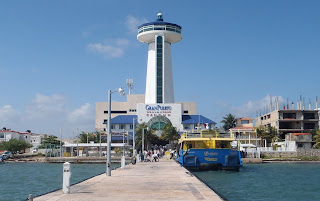 |
| UltraMar at Puerto Juarez on the mainland |
Living
on an island in the Caribbean Sea, there is only one way to get there – by
boat. Be it a passenger vessel, car ferry, or private yacht, we all have to cross
the water. Okay, one or two lucky people have small private planes that are
permitted to land on the seldom-used, almost-defunct airport. But the rest of
us peasants cross by boat; big boats, little boats, private boats, or commuter boats.
Every couple of years, we see a new addition to the fleet of passenger ferries bringing people to this little piece of paradise.
The vessels are getting bigger and bigger to accommodate the increase in visitors.
The newest multi-level arrival can transport 650 visitors to Isla Mujeres with each sailing.
The newest multi-level arrival can transport 650 visitors to Isla Mujeres with each sailing.
 |
| Posted on Recuerdos de Isla Mujeres! |
Before the UltraMar started business, the only passenger service to the island was provided by Ausencio Magaña and his family members. Their fleet included the La Carmita, a banana-shaped boat that rolled and wallowed in the seas, creating havoc with the tender stomachs of landlubbers and tourists. The preferred place for locals to ride was in the stern, well away from any seasick travelers.
 |
| 2002 Caribbean Miss |
The
next Magaña ship was La Novia del Mar,
and then the popular La Sultana del Mar. A fourth boat, La Dama Elegante, was equipped with a six-foot (2 metres) by two-foot (60 cm) glass insert for viewing the sea life. A sunken shrimp boat, the Blanca Beatriz, was rescued from near Isla
Contoy and refurbished. Although that vessel was primarily reserved for
circumnavigating the island with sightseers.
In
2002, our first trip to Isla was on the Caribbean
Miss owned by the Magaña family.
This modest craft
held forty people and a bit of cargo. I have never
been sea-sick, but the combined diesel fuel vapours and the slight rolling
motion pushed my tolerance to the limit.
 |
| 2005 UltraMar passenger ferry |
When we returned in 2005, the first UltraMar catamaran
was in service with interior seating for sixty people.
2009
saw the arrival of a larger catamaran for UltraMar with upper deck seating and
a capacity of 200 passengers.
Three larger boats holding up to 265 people
arrived in 2011 with flashy blue underwater LEDS lighting up the nighttime
crossings.
 |
| Flashy underwater LEDs on the UltraMar boat |
Still
not enough to deal with the thousands of visitors, UltraMar put a ship called the Bo Hengy into service for a short time. The company didn’t even have time to paint
the new boat in the distinctive blue and yellow corporate colours before it was put to use.
Spring break for many schools in Canada, the USA, and
Mexico is coming soon. The lineups will be huge, but with the new, larger ships in service, hopefully traveling back and forth to the mainland won’t be a problem.
Although if you live on the island, hiding out at home is the best solution during the crazy time of year. When you have sand, sun, margaritas, and cold beer all within easy reach, there is no need to leave home.
Although if you live on the island, hiding out at home is the best solution during the crazy time of year. When you have sand, sun, margaritas, and cold beer all within easy reach, there is no need to leave home.
Hasta Luego, Lynda, Lawrie, and Sparky
Murder and mayhem.
Revenge and romance.
Isla Mujeres Mystery series


%20Insta.jpg)



































